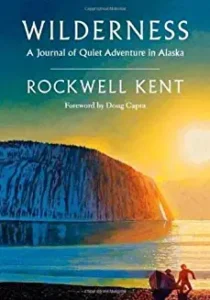Wilderness: A Journal of Quiet Adventure in Alaska by Rockwell Kent 1919 (reissued in 1996)
Rockwell Kent (1882-1971) is one of the most interesting artists/writers of the 20th C. Born into wealth in Tarrytown, NY, he was educated at Horace Mann School and Columbia and learned his art skills from William Merritt Chase and Robert Henri. The latter introduced him to Monhegan Island where he spent much of five years in his early 20’s. His need for freedom from the capitalist, accretive society he loathed led him to live in Monhegan, Newfoundland, rural Minnesota, Alaska, and finally, Arlington, Vermont where he penned the introduction to this volume in 1919.
‘Wilderness’ is the chronicle of his 8 month stay on Fox Island, a lonely outpost in Resurrection Bay, a 12 mile sail, row, or motorboat trip from Seward, Alaska. On Fox, he found Olson, an old Alaskan who lived there alone raising blue foxes and goats. Rebuilding an old cabin, he lived with his 8 year old son Rockwell, painting, cutting wood, writing to his estranged wife, Katherine, and living the life of independence and freedom that he was seeking. Returning to New York to attempt to save his marriage, his stay on Fox was cut short.
The book is rather dull since not much happens—the daily weather, the storms, the beautiful scenery across the Bay, the trips to Seward, the daily baths in the sea, the painting and ever more painting—but the precious time with his son and the ability to focus entirely on his art carry the reader through the quotidian and leave one with a sense of exhilaration and peace that belie the underlying tumult of his personal life. The very fact that not much happens on Fox Island is the message to the reader. As Kent wrote in his penultimate entry on March 17. 1919, “How long such a life could continue to charm one of course cannot know; but it is clear to us now as we leave it that we have only begun to know the wonders of the life and of the land. We are both resolved in our hearts to return here and explore freedom to its limits—truly a life time’s plan. We have learned what we want and are therefore wise. As graduates in wisdom we return from the university of the wilderness.”
I was drawn to this book because we had seen Kent’s lodgings on Monhegan during a wonderful visit to that island 12 miles off the coast of Maine several years ago. In addition, when I finally got around to reading Moby Dick a few years back, I read the 1930 Modern Library edition that featured Kent’s wonderful woodcuts. Kent’s Vermont connection firmly sealed my interest in the man and his work. Interestingly, Kent’s progressive politics led him to leave more than 800 works to the Hermitage in St. Petersburg, Russia. Major collections are accessible in the US at SUNY-Plattsburgh and at Columbia where his letters are stored.
This will not be a book that appeals to everyone. But if you have an 8 year old grandson, do some painting, or are still enamored of the fantasy of living in wild Alaska, this is a book you will enjoy reading and looking at the many paintings Kent created during that fertile period.



